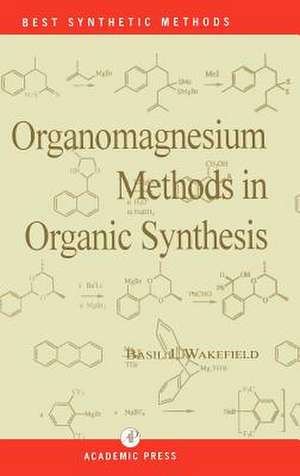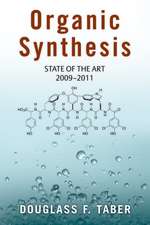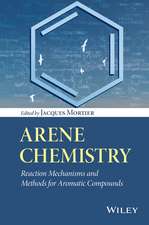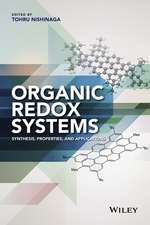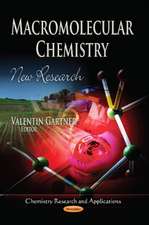Organomagnesium Methods in Organic Chemistry: Best Synthetic Methods
Autor Basil J. Wakefielden Limba Engleză Hardback – 15 mar 1995
The chapters on the synthesis of organomagnesium compounds cover the preparation of special forms of metallic magnesium and the reaction of magnesium with substrates such as dienes, as well as the traditional preparation of Grignard reagents. Preparations by metallation and metal-halogen exchanges are also included, as are newer methods such as hydromagnesiation of alkenes and alkynes.
Systematic coverage is provided on synthetically useful reactions of organomagnesium compounds. Of fundamental importance in organic synthesis are carbon-carbon bond forming reactions; additions to carbon-carbon, carbon-nitrogen, carbon-oxygen, and carbon-sulfur multiple bonds; and nucleophilic substitution at carbon. The formation of carbon-heteroatom bonds in organic compounds is described, where the heteroatom is hydrogen, nitrogen, oxygen, sulfur, or halogen. Finally, the use of organomagnesium compounds in preparing other organometalloid and organometallic compounds is outlined.
Representative experimental procedures are included throughout the book, and tables with references to well-described examples are provided.
- Presents a general overview of the constitution and reactivity of organomagnesium compounds
- Provides coverage on the detection and estimation of organomagnesium compounds
- Emphasizes practical aspects as well as principles
- Covers the preparation of special forms of metallic magnesium and the reaction of magnesium with substrates such as dienes
- Includes preparations by metallation and metal-halogen exchanges
- Reviews new preparation methods such as hydromagnesiation of alkenes and alkynes
- Outlines information on synthetically useful reactions of organomagnesium compounds
- Describes the formation of carbon-heteroatom bonds in organic compounds
- Addresses the use of organomagnesium compounds in preparing other organometalloid and organometallic compounds
- Includes representative procedures and tables with references to well-described examples
Preț: 758.76 lei
Preț vechi: 1039.40 lei
-27% Nou
Puncte Express: 1138
Preț estimativ în valută:
145.18€ • 151.99$ • 120.13£
145.18€ • 151.99$ • 120.13£
Carte tipărită la comandă
Preluare comenzi: 021 569.72.76
Specificații
ISBN-13: 9780127309453
ISBN-10: 0127309454
Pagini: 249
Dimensiuni: 152 x 229 x 20 mm
Greutate: 0.52 kg
Editura: ELSEVIER SCIENCE
Seria Best Synthetic Methods
ISBN-10: 0127309454
Pagini: 249
Dimensiuni: 152 x 229 x 20 mm
Greutate: 0.52 kg
Editura: ELSEVIER SCIENCE
Seria Best Synthetic Methods
Public țintă
Graduate students, researchers, and industrial chemists.Cuprins
Introduction and General References. General Considerations in the Application of Organomagnesium Compounds in Organic and Organometallic Synthesis. Preparation of Organomagnesium Compounds. Addition of Organomagnesium Compounds to Carbon-Carbon Multiple Bonds. Addition of Organomagnesium Compounds to Carbon-Nitrogen Multiple Bonds. Addition of Organomagnesium Compounds to Carbonyl Groups. Carbophilic Addition of Organomagnesium Compounds to Thiocarbonyl Groups. Substitution atCarbon by Organomagnesium Compounds. Carbenoid and Arynoid Reactions of Organomagnesium Compounds. Reactions of Organomagnesium Compounds with Proton Donors. Formation of Carbon-Nitrogen Bonds via Organomagnesium Compounds. Formation of Carbon-Oxygen Bonds via Organomagnesium Compounds. Formation of Carbon-Sulfur, Carbon-Selenium, and Carbon-Tellurium Bonds via Organomagnesium Compounds. Formation of Carbon-Halogen Bonds via Organomagnesium Compounds. Synthesis of Organoboron, Organosilicon, and Organophosphorous Compounds from Organomagnesium Compounds. Organomagnesium Compounds in the Synthesis of Other Organometallic Compounds. Index of Compounds and Methods.
Recenzii
"This book, like others in the Best Synthetic Methods series, is a compact and practical summary and guide to the application of an area of organic chemistry to the craft of organic synthesis. ...this is a useful book, whichresponds to a real need. In these days of proliferating literature, the student or practicing chemist who has access to this and similar references will have the edge." --JOURNAL OF THE AMERICAN CHEMICAL SOCIETY
